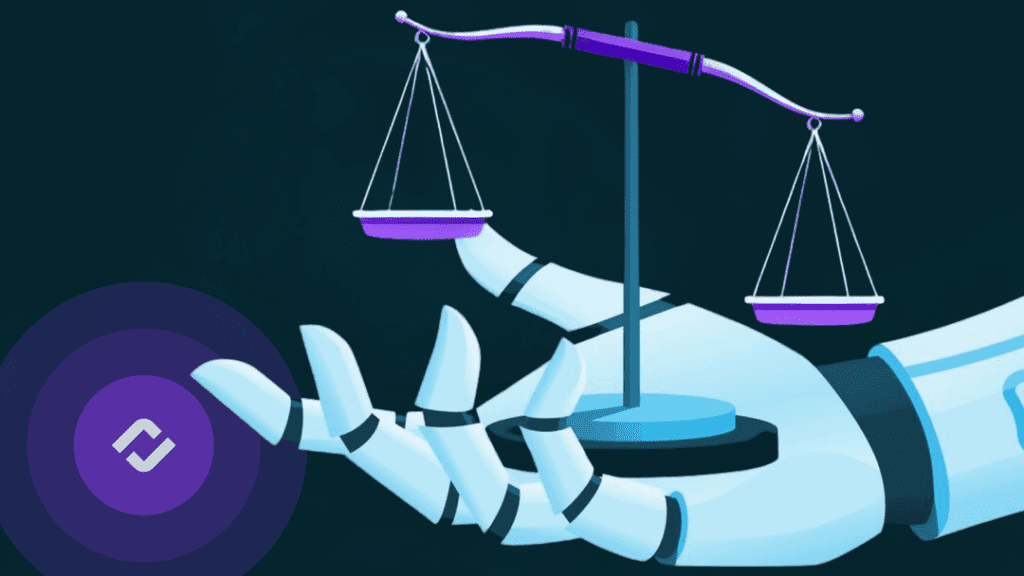
What Is Responsible AI?
Responsible AI is a broad concept that focuses on the ethical, legal, and societal implications of AI technology. It’s about ensuring that AI systems are developed and used in a way that is transparent, fair, and beneficial to all, while taking measures to avoid harm or misuse of the technology. In essence, it aims to actively use AI to promote positive societal outcomes.
Responsible AI is about balancing innovation and ethics in technology. It recognizes that while AI can enhance our lives and be enormously beneficial for society, it also has the potential to cause harm if not managed carefully.
Why Are Responsible AI Practices Important to an Organization?
When it comes to implementing AI within an organization, responsible practices are essential. Let’s explore why.
Regulatory Compliance
As AI technology continues to evolve, so too does the regulatory landscape. Governments and regulatory bodies around the world are increasingly focusing on AI and the need for appropriate oversight and accountability. By adopting responsible AI practices, your organization can stay ahead of the curve and ensure compliance with evolving regulations.
Public and Customer Trust
Responsible AI practices are key to building and maintaining trust with customers and the general public. In the age of data breaches and privacy scandals, consumers are becoming more aware and concerned about how their data is used. By being transparent about your AI practices, taking steps to ensure customers are treated fairly by AI systems, and communicating those measures, you can gain the trust of your customers and the public.
Quality Decision-Making
AI systems can process vast amounts of data and identify patterns that humans might miss. However, if these systems are not developed and used responsibly, they can also reinforce biases and lead to poor decisions. By prioritizing responsible AI, you can ensure that your AI systems make fair and accurate decisions.
Risk Mitigation
- Adopting responsible AI practices serves as a multi-faceted strategy to mitigate risks:
- On the legal front, compliance with ethical guidelines and regulations minimizes the chances of lawsuits and fines.
- Secure data storage and encryption maintain data integrity, reducing the risk of breaches that could compromise decision-making.
- By avoiding ethical lapses, such as biased decisions, organizations safeguard their reputation and maintain customer trust.
- Implementing resilient AI systems ensures business continuity by preparing for disruptions like cyber-attacks or system failures.
Related content: Read our guide to responsible AI examples (coming soon)
7 Pillars of Responsible AI
An organization aiming to practice responsible AI should ensure that its AI systems are:
1. Accountable and Transparent
AI developers must make sure that AI systems are designed in a way that their decisions can be traced and justified. This ensures accountability and promotes trust among users.
Transparency in AI refers to the clarity and openness in its development and application. You must clearly communicate the purpose, capabilities, and limitations of your AI system to stakeholders. This transparency helps to foster understanding and manage expectations, preventing misuse and mitigating potential risks.
2. Explainable and Interpretable
As the complexity of AI systems increases, so does the importance of understanding their decision-making processes. An explainable and interpretable AI can provide clear, understandable reasons for its actions and decisions.
Explainability is about making the inner workings of AI understandable to humans. This involves clearly communicating how the AI system makes decisions, the factors it considers, and the logic behind its actions.
Interpretability is about providing insights into the AI’s decision-making process. It involves articulating the importance and influence of different factors in the AI’s decisions, helping stakeholders comprehend and predict the system’s behavior.
3. Fair and Unbiased
Ideally, AI systems should treat individuals and groups equally, without discrimination. But in reality, most AI systems are biased, because they are trained on real-world data which contains inherent biases, and designed by humans who might have conscious or unconscious biases.
Managing harmful bias involves identifying and eliminating any prejudice or discrimination in the AI system’s decisions. This includes bias in the data used to train the AI, bias in the algorithms used, and bias in the system’s outputs.
4. Privacy Protection
AI developers must respect and protect user privacy at all times. Privacy enhancement involves implementing measures to protect user data and prevent unauthorized access.
This includes using secure data storage, encryption, and anonymization techniques. It also involves being transparent about how user data is collected, used, and stored, and obtaining user consent before collecting or using their data.
5. Secure and Resilient
In the face of increasing cyber threats, it’s important to ensure the security of AI systems. A secure AI system is one that is protected against unauthorized access and attacks, ensuring the integrity and confidentiality of data.
Resilience in AI refers to its ability to withstand and recover from issues, such as cyber-attacks, system failures, or data loss. This involves designing robust AI systems that can adapt to changes, manage risks, and recover from disruptions, ensuring uninterrupted and reliable service.
6. Valid and Reliable
A valid AI system is one that accurately achieves its intended purpose, while a reliable AI system consistently produces the same results under the same conditions. To ensure validity, you need to thoroughly test your AI system to confirm that it meets its intended objectives. This involves evaluating its performance, identifying any errors or inaccuracies, and making necessary adjustments.
Reliability, on the other hand, requires careful design and rigorous testing to ensure that the AI system consistently performs as expected. This involves monitoring the system’s performance over time, identifying any inconsistencies, and rectifying them.
7. Safe
Ensuring the safety of AI systems is vital to protect users and society at large from potential harm. This involves designing and operating AI systems in a manner that minimizes risks and prevents harm to users, third parties, and society as a whole.
Safety in AI involves implementing safeguards to prevent accidents, errors, or misuse. This includes robust testing to identify and mitigate potential risks, ongoing monitoring to detect and respond to issues, and establishing clear guidelines for safe use.
Tools and Technologies for Responsible AI
Due to the complexity and scale of modern AI systems, it is difficult to practice responsible AI without technology and automated tools. Here are some tools that can help in creating AI systems that are ethical and responsible.
Explainable AI (XAI) for Transparency
Explainable AI (XAI) aims to make AI decision-making transparent and understandable to humans. With XAI, you can unravel the complex layers of AI algorithms, gaining insights into how they arrive at their conclusions. This transparency enhances trust in AI systems and allows you to identify and rectify any biases or discrepancies.
However, implementing XAI requires a deep understanding of AI algorithms and a commitment to transparency. With XAI, you can ensure that your AI system is not a ‘black box’, but a transparent tool that makes decisions based on fair and logical rules.
Scenario-Based Testing
Scenario-based tests involve testing AI systems in real-life scenarios to gauge their response and performance. This testing method is particularly useful in identifying errors and inconsistencies that might not surface during regular testing.
By subjecting your AI system to different scenarios, you can see how it reacts in diverse situations. This gives you a comprehensive view of its performance, allowing you to identify any weaknesses or areas of improvement.
Learn how Kolena can help you test any ML workflow
Differential Privacy for Data Protection
Differential privacy is a technology that helps you protect data while still drawing valuable insights from it. It adds a layer of randomness to the data, making it difficult to link the data back to individual users.
Differential privacy strikes a balance between data usability and privacy, so you can use data to train your AI models without compromising on individual privacy rights. This not only ensures ethical use of data but also enhances trust in your AI system.
Robustness and Security Measures
Organizations must take a variety of measures to ensure AI systems can withstand attacks and unexpected circumstances. Robustness includes techniques like adversarial training, where you expose your AI system to malicious inputs to make it more robust, and fuzz testing, which tests if AI systems are robust to random and invalid inputs. Security measures include strict access controls, encryption, and application security controls like secure coding and traffic monitoring.
Automated Bias Detection Tools
Bias in AI systems can lead to unfair outcomes and discrimination. Automated bias detection tools can evaluate AI algorithms and data sets on fairness metrics such as demographic parity, equal odds, and positive predictive value (PPC) parity. They can identify possible bias, and apply algorithms that can help eliminate bias.
Best Practices for Building a Responsible AI Framework
While tools and technologies are essential for responsible AI, they need to be complemented with the right practices. Here are some best practices that can guide you in creating a responsible AI framework.
Use a Human-Centered Design Approach
A human-centered design approach involves designing your AI system with the end-user in mind. It’s about understanding the needs, preferences, and values of your users and reflecting them in your AI system. This approach ensures that your AI system is technically sound and ethically aligned with your users.
Understand the Limitations of Your Dataset and Model
Every dataset and model has its limitations. It’s essential to understand these limitations and factor them into your AI system. For instance, if your dataset lacks diversity, your AI model might be biased. Recognizing this limitation can prompt you to enhance the diversity of your data and ensure fair decision-making.
Identify Multiple Metrics to Assess Training and Monitoring
When training and monitoring your AI system, consider multiple metrics. These metrics should not only assess the technical performance of your system but also its ethical performance. For instance, you could measure fairness, transparency, and accountability, along with accuracy and uptime.
Rigorously Test Models
Rigorous testing is vital to ensure the reliability and ethicality of your AI system. This involves testing your AI models in diverse scenarios, under different conditions, and with various data sets. Such thorough testing allows you to identify any weaknesses or biases in your models, enabling you to rectify them to mitigate risk.
Continue to Monitor and Update the System After Deployment
Responsible AI is a continuous process. Even after deploying your AI system, you need to monitor and update it regularly. This allows you to adapt your system to changing circumstances, address any emerging issues, and ensure that it continues to operate ethically and responsibly.
Kolena: Supporting Responsible AI with ML Model Testing
Building responsible AI products that we and our customers can trust and rely on is not a one-time heroic effort or a new groundbreaking neural network architecture. It is a process of building a culture of AI quality in the organization that requires:
- Building high-fidelity test data
- A transparent model quality assurance process
- Testing end to end products not just the model
We built Kolena to make robust and systematic ML testing easy and accessible for all organizations.
With Kolena, machine learning engineers and data scientists can uncover hidden machine learning model behaviors, easily identify gaps in the test data coverage, and truly learn where and why a model is underperforming, all in minutes not weeks. Kolena’s AI / ML model testing and validation solution helps developers build safe, reliable, and fair systems by allowing companies to instantly stitch together razor-sharp test cases from their data sets, enabling them to scrutinize AI/ML models in the precise scenarios those models will be unleashed upon the real world. Kolena platform transforms the current nature of AI development from experimental into an engineering discipline that can be trusted and automated.
Reach out to us to learn how the Kolena platform can help build a culture of AI quality for your team.



